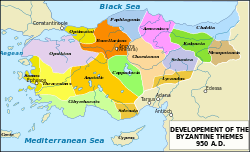Sebasteia (theme)
| Theme of Sebasteia Σεβαστεία, θέμα Σεβαστείας | |||||
| Theme of the Byzantine Empire | |||||
| |||||
 | |||||
| Capital | Sebasteia | ||||
| Historical era | Middle Ages | ||||
| - | Established | 911 | |||
| - | de facto autonomy | ca. 1074 | |||
| - | Fall to the Seljuks. | ca. 1090 | |||
| Today part of | | ||||
The Theme of Sebasteia (Greek: θέμα Σεβαστείας) was a military-civilian province (thema or theme) of the Byzantine Empire located in northeastern Cappadocia and Armenia Minor, in modern Turkey. It was established as a theme in 911 and endured until its fall to the Seljuk Turks in the aftermath of the Battle of Manzikert in 1071.
History
The theme was formed around the city of Sebasteia (modern Sivas). The region formed part of the Armeniac Theme from the mid-7th century.[1] The theme is not mentioned in any source prior to the 10th century.[2] In 908, Sebasteia appears for the first time as a distinct kleisoura (a fortified frontier district), and by 911 it had been raised to the status of a full theme.[1][3]
The theme comprised the entirety of the Byzantine frontier regions along the middle course of the northern Euphrates. With the expansion of the Byzantine frontier, it was extended south and east as far as Melitene, Samosata and Tephrike, corresponding roughly to the ancient Roman provinces of Armenia Prima and parts of Armenia Secunda and Syria Euphratensis. After the mid-10th century, however, its extent was much reduced by the creation of new smaller themes.[1][4]
In the 10th century, the region experienced a great influx of Armenians, who became the dominant population. After 1019/1021, Sebasteia and adjoining lands were given as a fief to the Armenian Seneqerim Ardzruni, in exchange for the cession to the Empire of his kingdom of Vaspurakan. From c. 1074, following the Byzantine defeat against the Seljuk Turks at Manzikert in 1071, the Ardzruni ruled the territory as independent lords, until it was conquered by the Turks around 1090.[1]
References
- ↑ 1.0 1.1 1.2 1.3 Kazhdan 1991, pp. 1861–1862.
- ↑ Pertusi 1952, p. 142.
- ↑ McGeer, Nesbitt & Oikonomides 2001, p. 128.
- ↑ Pertusi 1952, pp. 142–143.
Sources
- Kazhdan, Alexander Petrovich, ed. (1991). The Oxford Dictionary of Byzantium. New York, New York and Oxford, United Kingdom: Oxford University Press. ISBN 978-0-19-504652-6.
- McGeer, Eric; Nesbitt, John W.; Oikonomides, Nicolas, eds. (2001). Catalogue of Byzantine Seals at Dumbarton Oaks and in the Fogg Museum of Art, Volume 4: The East. Washington, District of Columbia: Dumbarton Oaks Research Library and Collection. ISBN 0-88402-282-X.
- Pertusi, A. (1952). Constantino Porfirogenito: De Thematibus (in Italian). Rome, Italy: Biblioteca Apostolica Vaticana.
| ||||||||||||||